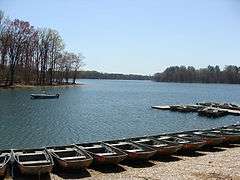Loch Raven Reservoir
| Loch Raven Reservoir | |
|---|---|
 | |
| Location | Baltimore County, Maryland |
| Coordinates | 39°27′N 76°34′W / 39.450°N 76.567°WCoordinates: 39°27′N 76°34′W / 39.450°N 76.567°W |
| Type | reservoir |
| Primary inflows | Big Gunpowder Falls river |
| Primary outflows | Big Gunpowder Falls river |
| Basin countries | United States |
| Max. length | 10.7 miles (17.2 km) |
| Surface area | 3.75 mi²[1] |
| Water volume | 23,000,000,000 US gal (0.087 km3) |
| References | [1] |
The Loch Raven Reservoir is a reservoir that provides drinking water for the City of Baltimore and most of Baltimore County, Maryland. Originally built in 1881 as a dam and water tunnel to channel water to Lake Montebello and Lake Clifton, a new dam, creating a modern large reservoir lake, was constructed in 1914 in efforts to increase the municipal water supply,[2] submerging the agricultural village of Warren.[2] In 1923, the dam was elevated from 51 feet (16 m) to 117 feet (36 m), and was viewed by many as a step towards the re-vitalization of Baltimore after the Great Fire of 1904.[3] It is fed by the Big Gunpowder Falls river, and has a capacity of 23 billion US gallons (87,000,000 m3) of water.[4] In addition to providing potable drinking water to Baltimore City and Baltimore County, the lake serves as a park and recreational area for the public to enjoy.

History
The reservoir began as ordinance 141 of the Baltimore City Council in 1908, and the initial funding of $5,000,000 USD. The dam was constructed between 1912 and 1914 and when completed its crest was 188 feet (57 m) above mean sea level, and 51 feet (16 m) from the original valley floor. The dam consisted of 50,800 cubic yards (38,800 m3) of concrete and impounded 1.5 billion US gallons (5,700,000 m3). Seven miles of new roads were constructed as well as three new bridges (Loch Raven Drive, Paper Mill Road, and Dulaney Valley Road). The only original bridge that still remains is on Warren Road. Additionally a 10-foot (3.0 m) steel pipe was built at a length of 1,623 feet (495 m) from the upper to the lower dam, which connected with the main tunnel running seven miles (11 km) to Lake Montebello in Baltimore.[5]
Bridges
The reservoir is home to historic bridges. Four bridges were built for roads to cross the reservoir. Loch Raven Drive's original bridge was built in 1906 on a dangerous road that included a hairpin turn which caused many accidents. On October 26, 1958 the bridge was subject to a UFO Case when two men in a car approached the bridge and saw an egg shaped craft floating above the bridge. Then they were burned when the odd object left. This case was investigated by Project Blue Book. In 1988 the bridge was removed for a safer bridge. The second bridge built was in 1914 on Maryland 146. It was a large bridge similar to the Warren and Paper Mill Road Bridges and known as the Matthews Bridge. The Bridge was demolished in 1978 in favor of a modern bridge.[6] In 1922 On Maryland 145 another bridge would be built in place of a covered bridge that once stood there. This bridge was later replaced in 2000 by a larger bridge. The 1922 bridge was preserved for recreational use. The final bridge and only one still in use is on Maryland Route 943 better known as Warren Rd. The bridge was built in 1923 and still in use today.
Activities
Loch Raven Reservoir is home to Loch Raven Skeet & Trap shooting range, numerous trails and picnic areas. Visitors can also go fishing or boat in their personal watercraft, and boats may also be rented dockside. The reservoir also has running trails and a frisbee golf course. In addition to these trails, on weekends Loch Raven Drive between Morgan Mill Road and Providence Road are closed to cars to allow use by pedestrians. However, because the reservoir is used to provide drinking water, swimming in it is prohibited. Officers of the Watershed Police of the Baltimore City Department of Public Works patrol the reservoir and its surroundings.[7]

References
- 1 2 Loch Raven Fishing Center
- 1 2 Arnett, 1999
- ↑ Michael Wentzel and Michael Shultz, 1977
- ↑ Loch Raven Reservoir : Details Page : Baltimore FunGuide.com
- ↑ Informational Plaque at site
- ↑ Photos
- ↑ Jim Joyner (June 22, 2012). "Loch Raven, Prettyboy and Liberty reservoirs off limits to swimmers". Retrieved 2012-09-22.
External links
-
 Media related to Loch Raven Reservoir at Wikimedia Commons
Media related to Loch Raven Reservoir at Wikimedia Commons -
 Geographic data related to Loch Raven Reservoir at OpenStreetMap
Geographic data related to Loch Raven Reservoir at OpenStreetMap - "The River You Drink", an interesting perspective on the history of the Gunpowder, which feeds into the reservoir, 5 part series from the evening Baltimore Sun
- Loch Raven local community advocacy group
- Loch Raven Reservoir on Google Street View
- "A short video of Loch Raven"
- Metro Reservoir Anglers, Inc.
- Historic American Engineering Record (HAER) No. MD-68, "Matthews Bridge", 11 photos, 2 data pages, 1 photo caption page
| |||||||||||||||||||||||||||||||||||||
